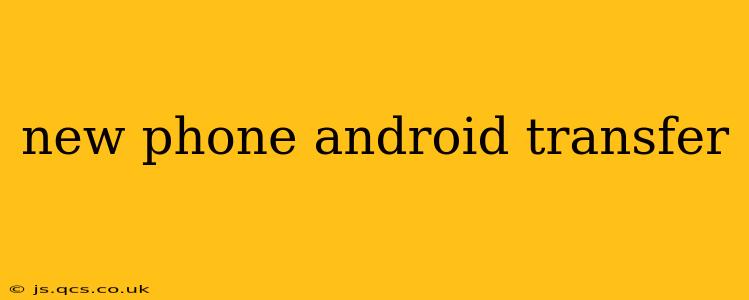Switching to a new Android phone shouldn't be a headache. Transferring your data – contacts, photos, apps, and more – should be a smooth and efficient process. This comprehensive guide will walk you through various methods, addressing common questions and concerns to ensure a hassle-free transition.
How Do I Transfer Data from One Android Phone to Another?
There are several ways to transfer data between Android phones, each with its own advantages and disadvantages. The best method for you will depend on your specific needs and the features available on your devices.
1. Using Google's Built-in Backup and Restore: This is often the easiest and most convenient method, especially if you've already been using Google services. Your data is automatically backed up to your Google account, and you can restore it to your new phone with ease. This includes contacts, calendar events, and app data for apps that support this feature. Remember to ensure your new phone is logged into the same Google account.
2. Using a Local Wireless Transfer: Many newer Android phones offer a direct wireless transfer feature. This allows you to connect your old and new phones directly and wirelessly transfer data quickly. This is usually faster than cloud methods if you have a large amount of data. Look for features like "Nearby Share" or similar options in your phone's settings.
3. Leveraging a Third-Party App: Several reliable third-party apps specialize in data transfer between Android devices. These apps often streamline the process and allow for selective data transfer, giving you more control over what gets moved to your new device. Always research and choose a reputable app with positive reviews.
4. Manual Transfer via USB Cable: While less convenient, you can connect your old and new phones using a USB cable and transfer files manually. This is a good option for transferring large files like videos or music, but it's more time-consuming.
What Data Can I Transfer to My New Android Phone?
Generally, you can transfer a wide range of data, including:
- Contacts: Your entire contact list, including phone numbers, emails, and other details.
- Photos and Videos: Your entire image and video library.
- Apps: Most of your installed apps, though you might need to reinstall some.
- App Data: The settings and data associated with your apps. This depends on app compatibility.
- Messages: Text messages can be transferred, but this method often varies depending on the phone manufacturer and messaging app.
- Calendar: Your appointments and events.
- Documents and Files: Stored files, whether from internal storage or cloud storage like Google Drive or Dropbox.
Can I Transfer Data from an Older Android to a Newer Android?
Yes, transferring data between Android phones of different ages is generally possible, regardless of the Android versions. The methods described above work across different Android versions, though you might find that newer features are available on newer devices.
How Long Does It Take to Transfer Data to a New Android Phone?
Transfer time varies significantly depending on the amount of data being transferred and the method used. A cloud-based transfer of a smaller data set could take just minutes, while transferring terabytes of data via a wired connection could take hours. Wireless transfers typically fall somewhere in between.
What If I Forget to Back Up My Data Before Switching Phones?
If you didn't back up your data, recovering it may be more challenging. Some data may be irretrievable, especially if it wasn't stored in the cloud. You might be able to recover some data using file recovery software, though this is not guaranteed and data may be lost. This emphasizes the importance of regular backups!
What is the Best Way to Transfer Data to a New Android Phone?
The "best" method is subjective and depends on your individual preferences and data volume. For most users, using Google's built-in backup and restore is the easiest and most convenient. For those with large amounts of data, a direct wireless transfer could be faster. Consider your priorities and choose the method that fits your needs.
By carefully considering these options and preparing adequately, you can ensure a seamless transition to your new Android phone, minimizing disruption and maximizing the enjoyment of your new device. Remember, always prioritize backing up your data regularly to safeguard your valuable information.
